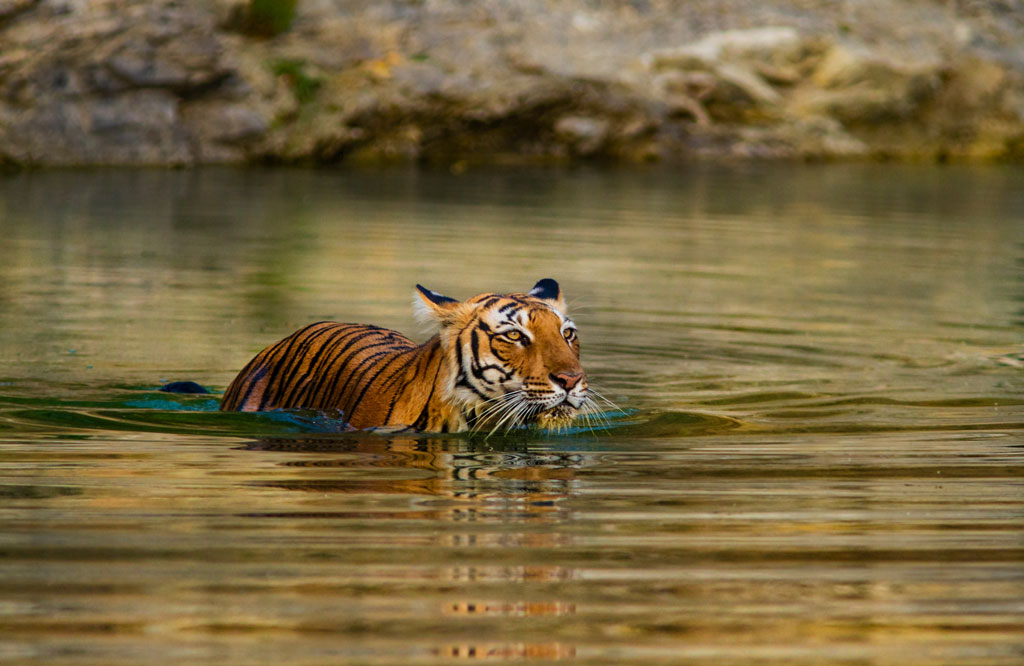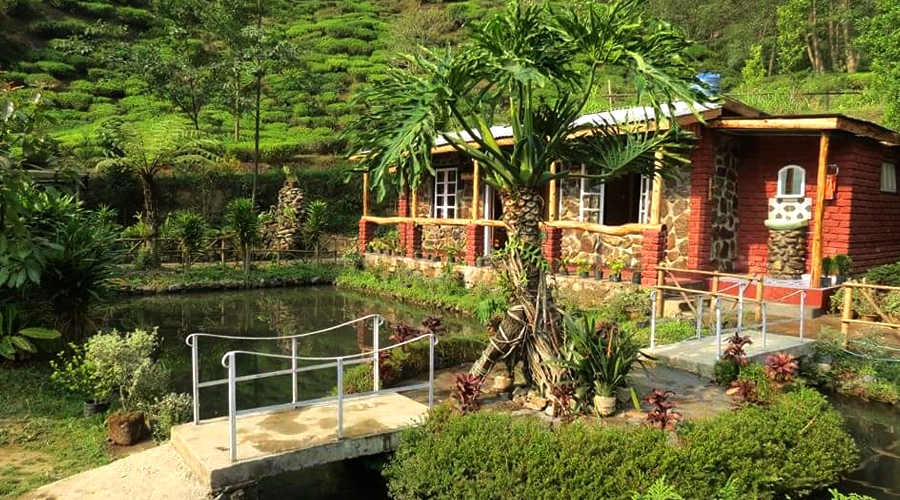Overview:-
Deriving its name from the pictorial fort inside, the Ranthambore National Park is one of India’s most renowned national parks. Located where the Aravali Range and plateau of the Vindhyas meet, Ranthambore National Park was once where the royals of Jaipur hunted. The national park is also considered a prominent heritage site due to the ancient ruins found inside.
The town of Sawai Madhopur is the gateway to the national park with a thriving biodiversity set among ancient religious structures, several man-made lakes and aesthetically-crumbling cenotaphs.
Although flanked by the Banas River to the north and the Chambal River to the south, the many lakes inside are not fed by either of the rivers’ waters. Having been declared a national park in 1980 with focus on protection of the endangered tiger, adjacent forests were merged with the Ranthambore National Park a little more than a decade later. The Sawai Man Singh Sanctuary and Kaldevi Sanctuary became part of the tiger reserve, making the national park at Ranthambore one of India’s largest.
You are bound to be enthralled to watch the splendid tiger roam about in its natural habitat, in the wild! Alternating between dry deciduous forests and swathes of grasslands, the Ranthambore National Park is recognised as one of the best places in the country to spot tigers. Today, sprawling across a little more than 1300 square kilometres including core and buffer area, the Ranthambore National Park is every wildlife enthusiast, photographer and a spirited traveller’s haven.
The Bakaula area is full of small watering holes, and the dense forest cover is a recommended region for spotting tigresses and her cubs. Zones 1-6 have been noted for a relatively higher number of tiger sightings. You are free to use your still camera without having to pay a fee, and the safari timings vary according to season. Usually, it is half hour after sunrise and half hour before sunset. In case a tiger had been spotted in a particular zone in the morning, it is highly likely that the predator is still in the vicinity in the evenings.
Or if the tiger has had a kill in a zone, it’s possible that the predator roams the area even 2-3 days after the hunt. To make sure you catch hold of the magnificent cat, multiple safari trips are a suggested way to raise the odds.
However, tiger sightings are fairly common at the Ranthambore Tiger Reserve. The hotter Ranthambore gets, better are your chances of catching the Royal Bengal Tiger in the wild. The tigers have grown used to human attention and do not feel threatened. Astonishing instances of the predator chasing and hunting down prey are recounted by guides, and if lucky enough, you might have your own first-hand experience by the end of it all.
Sloth Bears are another of the park’s secluded animals, coming out only during dusk. Lying in the rocky outcrops of Ranthambore Tiger Reserve, the Sloth Bear is difficult to sight. Be on the lookout anyway—you might just get lucky.
Flora
- The dry deciduous type of vegetation spans a wide variety of over 300 species. While the expanse of the park is dotted with really, really old Banyan trees, Dhok fill the forests in abundance. The dominance of Dhok is understandable as the region is prone to droughts and these trees are capable of surviving long periods without water.
Also, It is said that the country’s oldest Banyan trees are found here, even dating back to the ancient. Many seasonal streams flow through the forests, with the three big lakes here surrounded by Banyan trees—worthy of a postcard. Other species of trees that dot the forest terrain are Imli, Babul, Khajur, Neem, Nerale (Jamun), Kadam and many more.
Watch out for the beautiful flowers of the Dhak trees, whose unseasonal bloom in the arid conditions is so fascinating, it is also called the ‘Flame of the Forest’.
Fauna
Possibly the only place in India where you can sight the tiger hunting in the wild, the Ranthambore Tiger Reserve is well-renowned for its diurnal Royal Bengal Tigers. Not the least camera-shy, the tigers of Ranthambore are openly on the prowl which delights the tourists.
Leopards are scattered across the park in significant numbers, while mammals like the Nilgai, Striped Hyenas, Jackals, Hanuman Langur, Chinkara, Wild Boar, Indian Flying Fox, Sloth Bear, Jungle Cat and many others inhabit these forests. The reptiles need a special mention, and Ranthambore National Park is home to a large population of Snub-Nosed March Crocodiles. Monitor Lizard, Indian Chameleon, Ganges Soft-Shell Turtle, and snakes like the Cobra, Common Krait, and Indian Python are a few noteworthy inhabitants.
The diverse terrain of Ranthambore National Park sees numerous lakes, and boasts of a rich reserve of bird species. Over 270 varieties of birds flock here, with most birds being migratory. While Peacocks are found in abundance, the Great Indian Owl, Partridge, Parakeet, Spoonbill, Common Kingfisher and scores of other birds offer an engaging time for those of you who are birdwatchers. Add to the mix a few varieties of fish species in the lakes, and Ranthambore’s well-balanced ecosystem comes to the fore.other attractive place: Ramthambore fort, Padam Talao, Malik Talao, Raj bagh Talao, Amreshwar mahadeo Temple, Rajiv Gandhi measuem, Rameswar ghat, Kachid valley etc.
History:-
1955- The reserve was earlier being established as the Sawai Madhopur Gaming Sanctuary by the Government of India.
1973- Later it was declared as one of the Project Tiger Reserves in India.
1980- Ranthambore became a national park.
1984- The adjacent forests were declared as Sawai Mansingh Sanctuary and Keladevi Sanctuary.
1991- The tiger reserve was enlarged to include Sawai Mansingh and Kaladevi Sanctuaries.
The Ranthambore National Park is best known for the tiger population and is one of the perfect destinations in India to witness the majestic predators in the jungle living naturally. It is the only reserve in the region where the tigers can be easily witnessed at any point of time. This is the reason why the region is superbly famous for the tiger tours.
Itinary:-
How to reach:-
For a perfect reason and season of November to March the tourist/ tiger lovers can make their tiger trip in Ranthambore more successful and is closed during monsoon in the months of July to August.
By Air : Jaipur being the nearest airport to reach Ranthambore is simply at 180 kms of distance from the reserve area.
By Rail : Ranthambore National Park is around 11 km away from Sawai Madhopur railway station that lies on the Delhi to Mumbai trunk route.
By Road : Ranthambore is the area which is directly connected to many road links with a good network of buses to reach at Sawai Madhopur. Though the frequency of bus services is not great but and is best advisable to hire a car or taxi to reach at Sawai Madhopur. The Kota-Ranthambore mega highway is simply 1.5 kms away from the location.
Number of days:-
Do’s & don’ts:-
Climate:-
Season:-
Located in the eastern part of the desert state of Rajasthan, Ranthambore experiences an arid subtropical climate. Extreme temperatures are typical of Ranthambore, with temperatures peaking at over 45 degrees in summers and dropping to a chilly 2 degrees during winter.
From early October till the last week of June, moderately warm temperatures during the day and cool temperatures at dusk are particularly welcoming.
Ranthambore National Park is not open all year round, with monsoon months being breeding season, the park remains closed from July till September. However, it is advisable to visit during summer as your chance at sighting wildlife increases manifold. And winters are for those of you who’d rather take it easy and cool, and try their luck at spotting wild animals. The Ranthambore Tiger Reserve’s proximity to the Golden Triangle of Delhi-Agra-Jaipur makes it an increasingly popular destination.
Stay here:-
For a perfect tiger tour in Ranthambore, some relaxing amount of time to devote is really needed. As it is not a matter of one day to explore all the tigers in the area. This is the reason; the tourists should make some comfy arrangements for accommodation at Ranthambore hotels and resorts. Depending upon their days to be spent here and the demand of their comforts, the area is skill fully being casted with great accommodative options. Although government lodges are available in the region but for a luxurious and urban stay amidst the natural environment there are other beautiful options of hotels and resorts in Ranthambore.
Built in 2006, near the gates of Ranthambore Tiger Reserve, Tiger Machan is one of the most exciting places to camp and enjoy the chilly forests of the night. Perhaps the best way to watch the animals roam about in the wild, camping in aesthetically-done tents and a bonfire is sure to thrill your family.
Tiger Machan also conducts jeep safaris, and provides multiple luxury tents alongside nature walks and trips into the adjoining villages. 18 air-conditioned cottages, a couple of suites and eight luxury Swiss cottage tents are set amid soothing landscapes. Barbecues during the bonfire see cultural shows indulging you in the magic of Ranthambore. A walk to any of the three lakes promises to be a treat for birdwatchers. Prices start from INR 4500 upwards.



